Conversation
Flowstone
Multi-discipolinary artist MK Guth joined artists Susan Murrell and Hannah Newman in conversation with a live audience about their collaborative exhibition, Flowstone, presented at Carnation Contemporary in January 2023. The following transcript is edited for length and clarity.
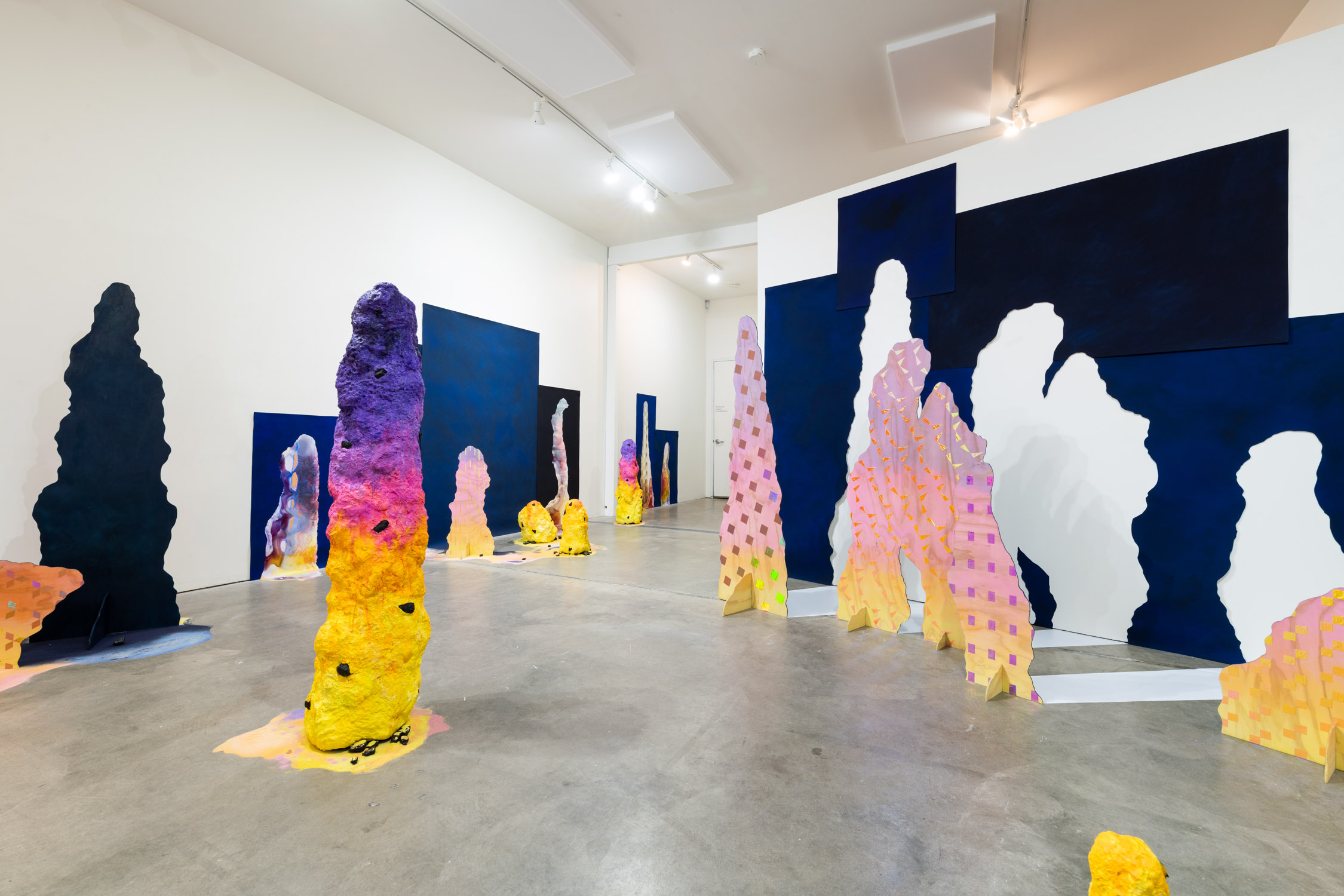
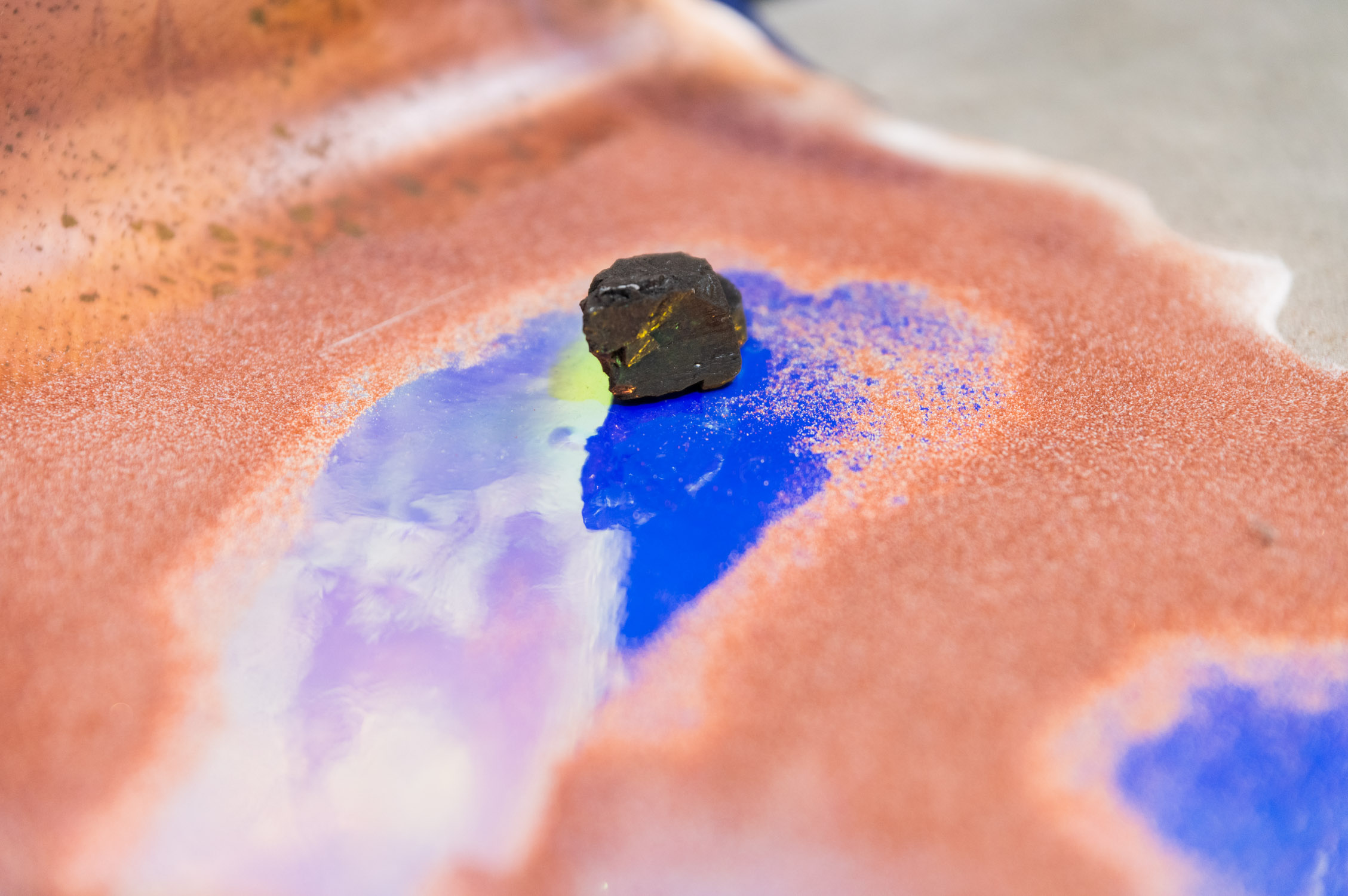
MK Guth Hannah and Susan, at first glance, I’m not sure that you would think that your work shares a lot in common, but really the thought behind your practices holds a lot of similarities. You’re both artists that make use of poetic gestures, in different ways, both within the context of materials and work, but also in the use of language and to the use of abstraction. The way that you ask the audience to reconsider what they know, what they see, and what they understand and then to go forward and ask us to reimagine other possible futures is part of what makes this exhibition so compelling and so profound.
To start this conversation out, I'd love to ask the two of you about how you came to collaborate. Collaboration is a term that gets thrown around a lot, but it doesn’t mean one thing. It means different things depending on how you’re coming to the work and to the form of engagement and to who’s pulling it together. How did you come to work together, and what were your expectations or goals in regards to the collaboration itself?
Susan Murrell It partially started because of the logistics of the season for Carnation this last year, in that the members decided to have two-person shows. It seemed like this great opportunity for people to figure out who they might want to work with or whose work would play well with someone else’s even if they had two distinct solo shows within the same space. Right away I texted Hannah, “Hey, let’s do this together!”
Early on we had our first meeting where we just shared our mutual appreciation for each other's work and identified crossover.
Hannah Newman In Carnation’s last show season, Susan had this really beautiful show called if water had its way, which was an immersive, compelling exhibition exploring different aspects of water in an abstract way. My experience of that show really made me want to work with Susan. Not just have our work in this space together, but to do something that was collaborative and put our two practices together.
The beginning was interesting since we practice in different cities. Susan's in La Grande, I'm here in Portland so almost all of our meetings were over Zoom. We started at first by just talking about what we were thinking about in our studio practices.
SM At the time I was reading a book, Underland: A Deep Time Journey by Robert McFarland, and recommended it to Hannah and then just things kept unfolding from there.
HN After I read the book Underland, we used some of the ideas from the book as seeds to start building the exhibition around.
SM Hannah was making these stalagmite forms. And, at one point in a Zoom meeting, she showed me the forms. They were in the hallway, just poking out of the doorway. They felt like such a presence. These strange beings were just in her kitchen. (laughs)
I was immediately drawn to them because of this concept of axis mundi, where the underground and caves are thought of as a stem system that links the underground with the heavens. I thought the forms were these beautiful, very visceral, symbolic figures that linked to that idea. The stalagmites became a starting point, and our work started revolving around this form.
There was lots of back and forth sending images. I would cut something out of plywood and then I’d send Hannah pictures, and Hannah would send me heart emoji, heart emoji, clap emoji, etc. We just kept riffing off each other’s work that way. I don’t think either of us wanted to make big decisions without the other but we had to work independently. We would just check in and send pictures, to make sure the work would mesh and do what we had envisioned in the end.
MK Often, when artists come together to collaborate the goals or the expectations are different than when working for ourselves. How did the call and response nature of your collaboration affect your goals for the outcome of this exhibition?
SM I was excited about the prospect of working with a sculptor and someone that dips into different media. With Hannah’s work there’s always this play between the physicality of actual objects and then the representation of them digitally. Our work speaks a similar language, but in very different ways.
As an artist over time you develop your toolkit and it can start to feel stale. I wanted to be stretched in different directions.
HN I think that I had to let go of my expectations. Sometimes as artists, we get so in our head about our own work and the expectations that we place on what we want our work to do. I knew that whatever Susan was going to do and bring to the table was going to be something I was excited about. Having that trust kind of allowed me to let go of the expectations of what was going to happen because I trust Susan’s work.
For a lot of the exhibition, we didn’t quite know how it was going to look until we started installing and brought all the work together for the first time.
MK Taking into consideration the new materials each of you brings to the collaboration, how did that affect how you created this layout and the intended experience for the viewer? It seems the longer you spend with the show, different aspects reveal themselves. New discoveries emerge over time.
SM We had talked about the different forms and how we wanted them to function within the space. We were prepared for that. But when we got here and really pulled everything out, we realized how much we had. We came in with so much because there was a certain amount of fear of not exactly knowing what was needed. So the composition changed a little bit.
HN A lot. (laughter) We had a pretty strong vision for this moveable wall in the gallery. We knew that it would be the perfect size to create a really strong visual with this set of flat pieces, with the absence of the shadow.
That piece was the starting point to set up. After we had that in place we could work to see what else we wanted to place around the room.
SM When we first got here, we thought that the flat pieces, which I nicknamed the paper dolls, would be facing the other 3-D sculptures. But then we started playing around with mixing the forms and found that to be beautiful.
I didn’t know how important the backs of the flat pieces would be until we started arranging them in the space and saw them playing off one another. This relationship emerged as we kept playing around. We were thinking of it as moments to arrange, but different elements seem to emerge as the viewer walks through it. It surprised us too.
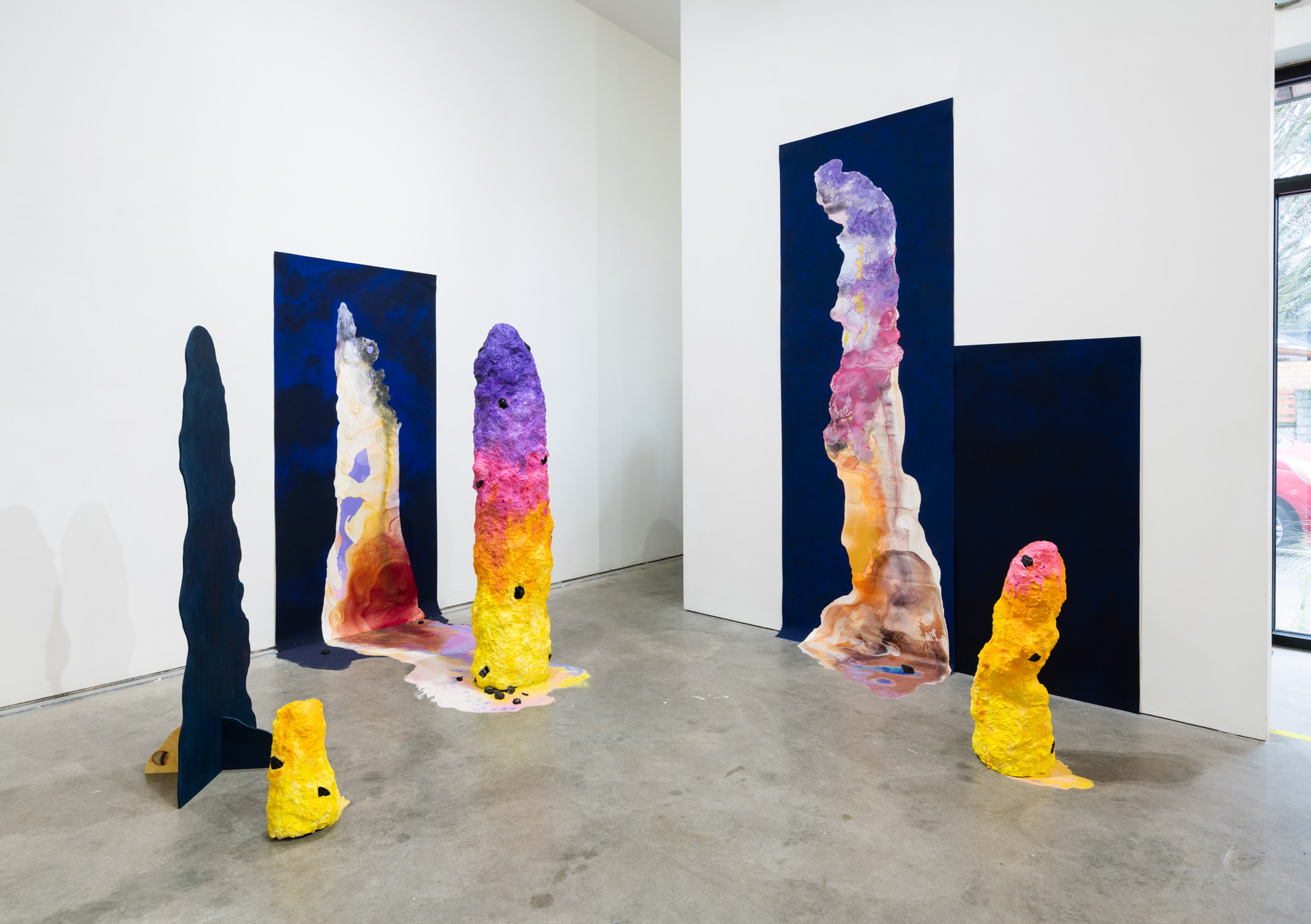
MK It made me aware of how I was being forced to move through the space in very particular ways. I had to look down and up because nothing is hung at the traditional viewpoint. I’m moving around objects that are similar to my own body height which made me very aware of my physical presence in relationship to the work.
You both are very materials- and process-based in your work but your materials are not always evident. There is some twist of hand, where we think we’re looking at one thing, but we’re actually looking at something else. Tell me a little bit about the different processes and the materials used in the exhibition?
HN This year I knew that I would be working with Susan, and I also knew that I wanted to use more nontoxic materials in my practice. I had been using this epoxy clay for some of my sculptures. But this year I switched over to this combination of sand, Elmer's Glue, corn starch, cement and paint mixture to make my own clay. Then embedded inside are alternatively bits of obsidian and coal, two materials that humans have been using for a long time, for a lot of different practices.
I knew that Susan used sand as a big part of her world building. So I felt that including sand as a part of a tactile element in those sculptures would be really interesting.
And then for the sound piece, it includes a lot of research and information, which I also consider a material.
SM In my painting practice, I use a lot of mixed media, but I’m generally starting with a pour on watercolor on a polymer paper and letting the pigment settle over time. There’s spontaneity in how it evaporates, and depending on the size of pigment particles it creates all these nice crackly textures as they move around and settle. Then I go back in with acrylic and paint the blue black in a vinyl paint. Opacity and transparency have been part of my practice for a long time. I feel like it creates a weird sense of depth.
I remember visiting the City of Rocks in New Mexico where I grew up and having this strange experience where the rocks felt more transparent to me than the sky. The sky in between the glittery sandstone appeared to be the solid thing and the rock felt more transparent. I’ve been playing with that for a while. And then on the floor, it’s just colored sand.
MK How often do people mess with that sand?
SM A lot of people need to touch it to convince themselves of what they are looking at, which is fine. I don’t mind that. That is one of the reasons that I’m so drawn to installation and why I like these composite paintings. Building your reality with multiple images and on multiple planes, it has this destabilizing effect where then everybody has to be cognizant of where they are in space. I think people become more aware of their own sensory experience.
MK Hannah, the audio piece you created for the show is both beautiful and confounding. It brought thoughts to my head that had never occurred to me before. The hair on the back of my neck actually stood up. Can you talk about the construction of that piece, the piece itself and the bibliography you created with it.
HN So if anyone hasn’t had a chance to listen to the audio piece I created for this show is about 14 minutes. I knew that I wanted the audio piece to be about the land, Earth, rocks, and physical materials. The piece is about the kinship between humans and other things in the world. The same materials that make up my body make up a rock and make up a smartphone. I wanted to ask how we can have more of a kinship with the materials and the non-living things around us?
A large part of my practice includes a period of gathering. I gather both rocks and then gather ideas through reading and listening to podcasts about specific topics that I know I’m interested in. Once I gather all these thoughts from other people that resonate with me, I rearrange them into a script that becomes the audio piece.
I include a bibliography because I think it’s important to acknowledge that these thoughts are not necessarily my own, that I’m using them as a material and reshaping them in a new way of thinking that the authors probably were not considering. A lot of these texts are science-based texts, but then I’m playing with them in a non-scientific way from my layperson understanding of science.
When we were first thinking about this show, we were talking about the whole exhibition as existing in a cave. I thought that creating this cave-like atmosphere would be an interesting spot to listen to the audio piece.
Within the piece there’s this section about the void that’s in everything. And I thought Susan's paintings with the really deep and beautiful blues represented that well.
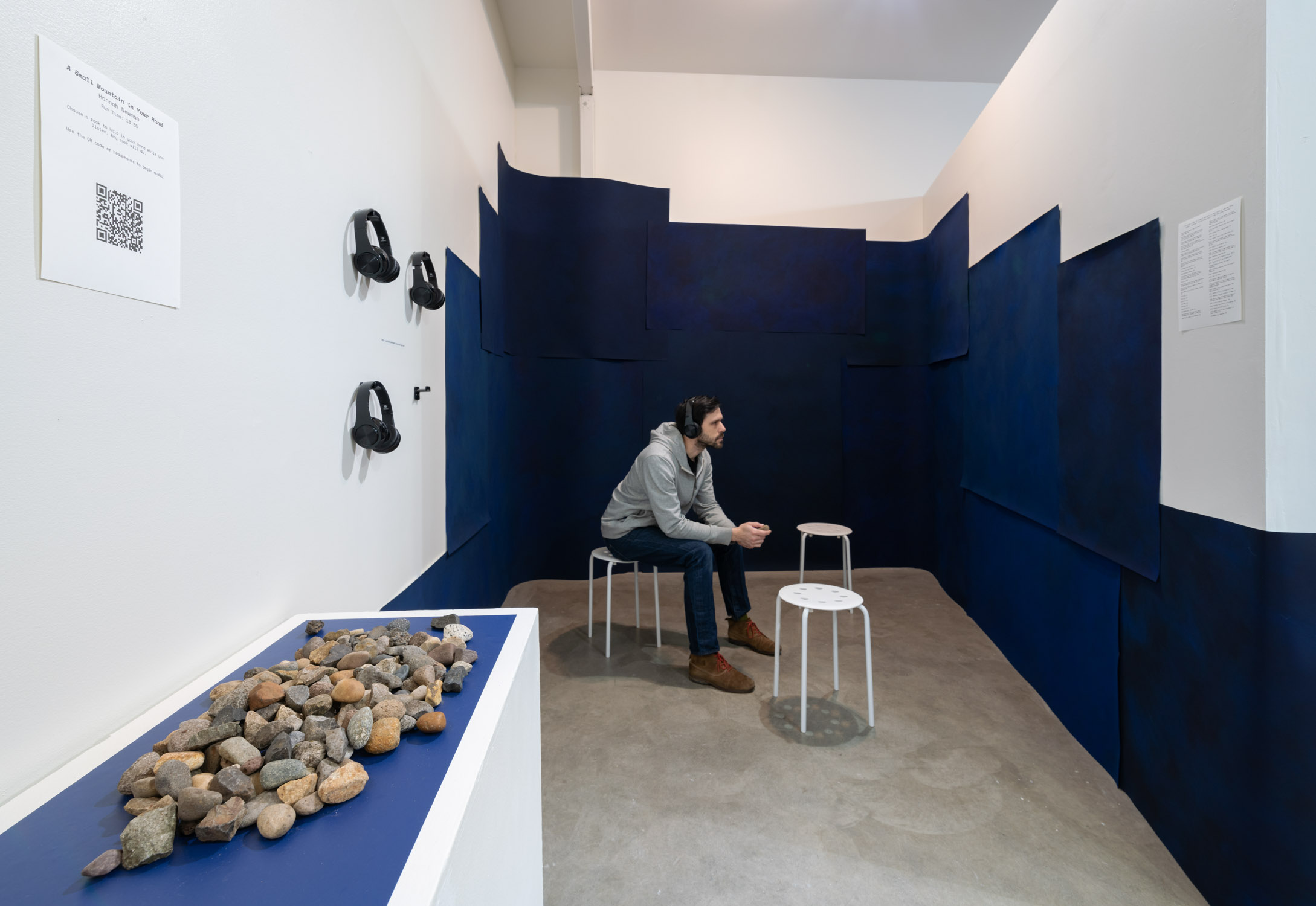
MK I was really taken by the show’s press release. The use of language is very beautiful, very poetic and seems to be a large part of your world building. How does language inform your making and your understanding of the experience for your audience?
SM Hannah and I are both big readers. That was one of our connecting points, and one of the reasons we sought each other out is because we are interested in similar texts.
I have this tendency, when I’m making things, to give them nicknames. It’s usually grounded in verbiage that has layered meaning. It is important for me to articulate what I’m doing or rather what I’ve done. It brings clarity to my thoughts and intentions. I don’t really know what I’ve made and don’t quite understand it until I’ve written about it after the fact.
Maybe our statement would be a bit different or we would have another paragraph or two if we wrote it after we installed the work!
HN I think language is just another kind of world-building for me, and being particular about language is important. I think there are ideas that maybe we can’t recognize or acknowledge until we put language to it.
SM So much about being a visual artist is totally vulnerable and on your own. People either like it at the end or don’t, but you don’t get much feedback along the way. Writing the statement together was a fun process. It actually happened pretty quick because we had had such in-depth conversations and we had also been talking very specifically about the objects that we were making, why we were making them and how we wanted them to function within the space.
MK The exhibition is filled with non-stop dualities, contrasts and tensions, from the relationship between the earth and the body, the landscape and the figure, the real and the imagined, quiet versus loud and party aesthetic versus contemplative. There are all these things that are creating a form of tension that amplifies the experience in this room. Can you discuss some of these dualities, how you think about them, and how they manifest in this work?
SM One overarching strategy in my painting practice is playing with positive and negative space and exploring the inversion it can create. When it’s negative inside it’s a cave, and then when you switch the negative space to the outside all of a sudden it becomes an organism.
So with that in mind, when I saw Hannah's sculptures, I loved the mixing landscape and figurative work in one form. It just put a smile on my face. Landscape painting and figurative sculpture, just kind of put in a blender! I was also drawn to the materials that she was using to represent a very fleeting moment and airy transition of sunset. Then the materials were so visceral and granular. The sculptures were big and took up space. So those were two contrasts that really got to me at the very beginning when we started out.
HN I was thinking about absence and presence. Space that’s taken, space that’s empty. In terms of presence, we have three reiterations of the same form. There is the very 3-dimensional work, then a mix between 2D and 3D, and then we have the flat 2-dimensional work on the wall. I like exploring the tension between the “virtual” and “real.” It has been something I’ve considered in my work for a long time.
One thing that Susan and I discussed, and I don’t know if this comes through in the work or not, is the idea of coming to the world with multiple perspectives. There are so many different things going on in the world, fake news, so many different perspectives. It just seems like the world isn’t as concrete as it used to be. Everything feels multiplicitous. That was a word we talked about. One install strategy we had talked about that didn’t materialize in the show was having one sculpture with 10 different shadows in a circle around it, like there were multiple light sources or viewpoints.
SM We intended to explore dualities in a very abstract way. The paintings we were thinking of as being the sunset shadows, impressions of these sculptures or maybe the impact of the objects and how people misremember things in different ways. Some small incidents can have looming effects on people.
With the sunset paper dolls we wanted to be the fake, designerly, impressions of something that’s more visceral. So that’s why they brought in some geometry, designer influence. I was calling them paper dolls just because of my personal experience as them being very unsatisfying toys. I’m a child of the seventies, so on road trips I’d get a book of paper dolls tossed in the backseat and found them very unsatisfying. I remember you just poke them out, put on another outfit with tabs, like, “I’ll try on this identity.”
MK It’s like they are removed–the paper doll is a version of a real doll, which is a version of the human body. This goes back to my point about the real versus the imagined or the unreal. This (points to sculpture) feels “real”. This (points to paper doll sculpture) feels like the prop of the real thing.
There are all these different swerves, or slippages, in the work. You don’t allow us to settle anywhere and feel confident about one thing. Each object, each image is challenging. Was that part of the plan?
SM I think that’s part of the fun. Taking a relatively simple form and repeating it, having such a strong motif. I think it highlights all the different ways that we interact with different media. Again, I like the idea of having a viewer navigate the space and trying to figure out what they’re looking at, struggling to really start to know where they are in space. That’s part of the puzzle. The viewer themselves is completing the work with whatever’s happening in their mind as they see little moments or make connections between one form and another.
HN I feel like I haven’t been so physically uncomfortable in a show in a while! During the opening I would be talking to someone and all of a sudden I’d have this moment where I thought where are my feet? If I move my feet, am I stepping on something? So it’s this really interesting space that makes you just a little bit uncomfortable in a way that other shows don’t.
SM There’s no clear delineation between the art and the room.
MK The last idea I want to poke at is this idea of earth as body. ‘Body’ is a little different than ‘figure.’ You bring it up multiple times in the audio piece. We’re confronted with these because they’re mounds, they’re earthlike. We connect them to things that we understand in nature and it too, repeats in different ways. Can you talk about the importance of that suggestion in the work? Can you talk about that a little bit? I’m actually looking at Hannah because it comes up over and over again in the audio piece, which then reinforces and changes what you see here. You listen to that and then all of a sudden this has just a slightly different tone or suggests new meanings.
HN I think there are interesting metaphors that we can try on in art, and that allows us to see things a little bit differently. If you think of yourself as the earth, what does that do for your perspective? What if you are thinking of yourself as the sky or air? I think that’s what art does. It gives us a place for our minds to be a little freer, a bit more poetic and try these things on and see, ‘if I place myself here, what does that do for my perspective?’
From a very scientific view we're all on a spectrum of materials. There's raw materials and refined materials and everything is somewhere on that spectrum between the two, right? We deal with so many refined materials in our daily lives that it can be hard to connect with raw materials. I'm interested in thinking about that spectrum.
MK Do you have any questions that you’ve wanted to ask of the other, or is there a question that you want to put out there that I didn’t ask, that you think would in ways, illuminate aspects of this exhibition?
SM I’m curious with Hannah’s work if the research comes first or if the impetus to make particular things comes first and then you feel like you need to delve into a particular process or a particular subject, particular discipline.
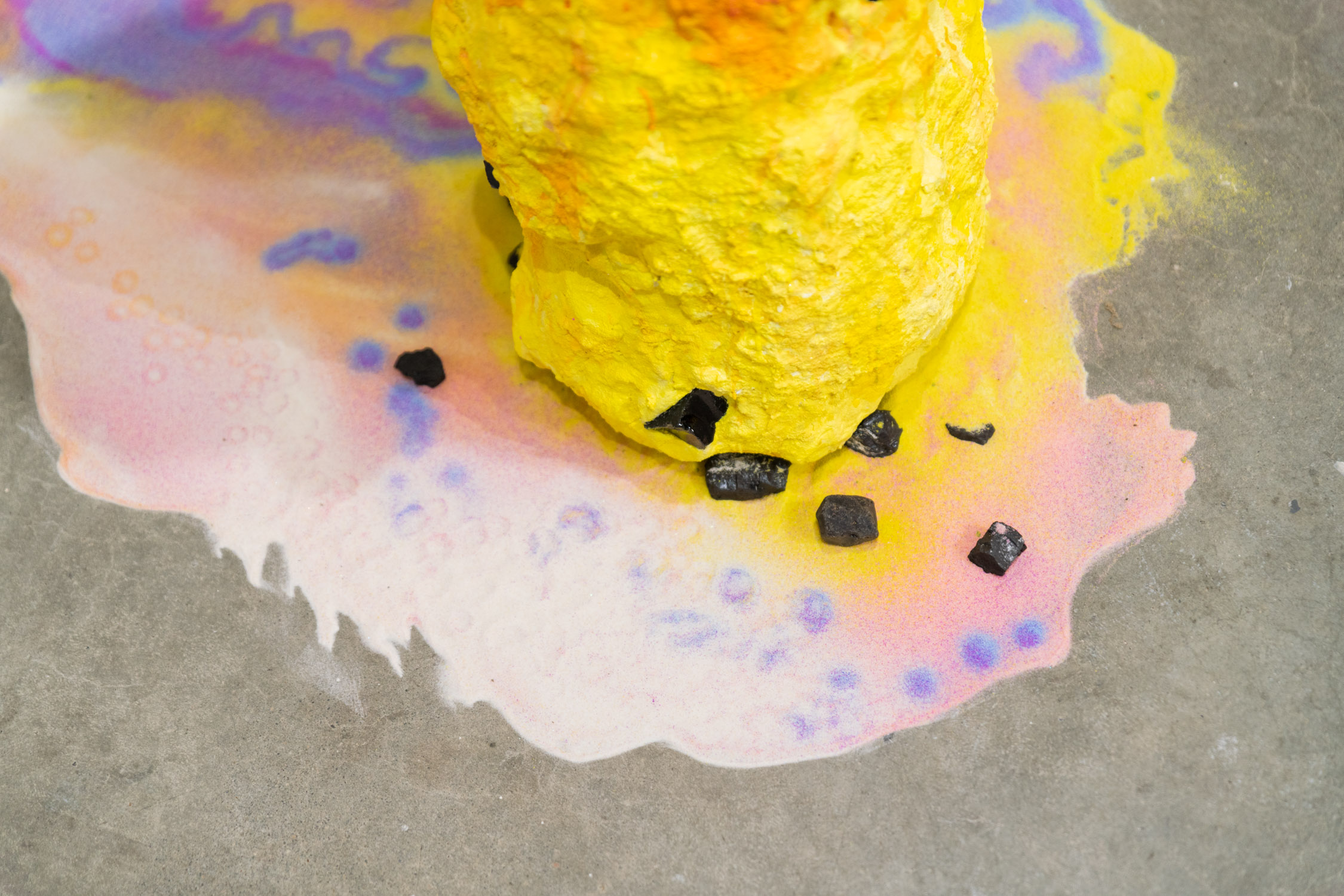
HN I think they tend to kind of both happen at the same time. I have two very distinct parts of my practice where there are times when I’m reading and researching and then writing around that research. Then I go into the studio and start cutting out an armature for a sculpture.
I think coming to a place where you kind of trust that the research is going to inform the work without forcing it to and feel like you’re striking a balance between all of the things that are feeding into you and the output. And not putting too much pressure on what the result is gonna be. I do think they happen pretty simultaneously. One without the other gets to be too much of the same thing. I need to be doing different tasks to keep myself engaged in my practice.
I don’t know if I have a question for Susan, but I feel like what I am going to take away from working with you is just how fun it has been to watch you work. I got to see you do watercolor and I got to see you paint with sand and I feel like the materiality and the freedom of your practice is just really inspiring.
MK Ok. Thank you. I love that. As you know, I work with a lot of different individuals and I’ve had a collaborative practice for a long time, and it’s amazing how when I work with people, how I’m always taking something away that then becomes important to me in my practice. I think I’ve learned so much over the years, and it’s really rewarding working with another maker because, like it or not, it affects the way you then come to your practice from that point on.
MK So let’s talk about the color palette! On the one hand, you have a neon party but there are other parts that are very slow and quiet. It’s both of those things together. As you built your world, how did you start building the palette, and did it change over time?
SM We wanted to keep to a sunset palette, which I loosely did in the painting. I went a little further again for reasons that I explained before, to represent off-gassing or the impression or a memory of the original sunset. The color palette really started with sculptures Hannah was already making.
The colors are super different than I would normally use! At one point we had a discussion about the dark blue/black I often use in my work. I wasn’t sure if I should use it for this body of work. I didn’t want to use it if there wasn’t a reason. But I feel like the blue-black brings a reference to cosmos and the void. It speaks to that contemplative vibe, which is why I use it in my regular practice. In this show, I feel like it helps ground the other work, and gives some high contrast depth to the pastels.
HN Yeah! I feel like at one point you asked me, ‘should I do the blue/black?’, and I said, ‘you have to!’ It’s vital to the show.
SM The shiny pink aspect of it all was one of the liberating parts of the collaboration. I don’t think I’ve ever made a purple/pink painting before! It’s liberating because we are making decisions together and it’s on the edge of my practice. I’m not totally responsible for all of it. So there’s less preciousness or intensity about it, which I think is great! I think we as artists just need to loosen up sometimes!
MK So do folks have questions?
Audience member Thanks so much for this. One of the things that I think about for a show like this is how future forward it is, despite the fact we’re talking about rocks and evidence of motion and distillation and that good stuff. I was wondering how you both feel about the audience experience being so physical in this installation, but the future of this work is going to be digital. Anybody that didn’t come here is going to see the documentation. What do you think about the audience experience for those who encounter the work digitally in the future?
HN Well, thank goodness for video!
SM All artwork is so different when you see it in person; photography is not the same on your phone. Of course, we’re getting good documentation and a video. But I like the idea that it’ll never be here again. I always feel like that feeds back into my practice too, the conceptual side of things, of ephemerality. This is the one time that it’ll be like this.
I’m always amazed, even when I install the same shows in different spaces, how different they come across with placement. That compositional, navigation element really changes the feel of the work. It’ll never happen again. Just like the sunset motif that is present throughout the show. It’s this little sign of an ending, but it’s also repeated. It’s the beginning of the next, too. I lean into that.
HN We were talking a lot about sunset being an end to certain things, and maybe there are certain things in society that we should end, so that something else could start. We want to ask, ‘what are some new things that we could put out into the world as a possible future?’
SM I think of the constancy of matter, things aren’t going to be the way that we remember but there’ll still be something. So that’s an interesting hopeful thought, as well.
MK I like that question because it poses, especially in work of this nature, if the documentation actually becomes a new work for the audience. Because you’re just not going to ever experience this again. Right. Things get flattened out. Like, I mean, I’ve been seeing the sand in your images, but I never knew it was sand. I thought, ‘you’re gonna get in trouble for that.’
SM MK thought I made a mess!
MK Yes but also I was thrilled about it! I think that’s something about work like this, that might be slightly different than a photograph. It actually offers up a new experience for the audience. And I hadn’t thought about it until you put that question out. It’s nice.
MK Lastly, I am going to read this, because last night, as I was thinking about the work and ironically, because I don’t like going down this path, I was thinking about Graham Harman’s object-oriented ontology. He describes objects within this kind of theoretical precept as unified realities, physical or otherwise that cannot be reduced either downwards to their pieces or upwards to their effects. I think that does a really nice job encompassing this show. I want to thank you for inviting me to engage you in conversation, and I want to thank everyone in the audience for being here today. And thanks for making great work.
photo credit: Mario Gallucci
